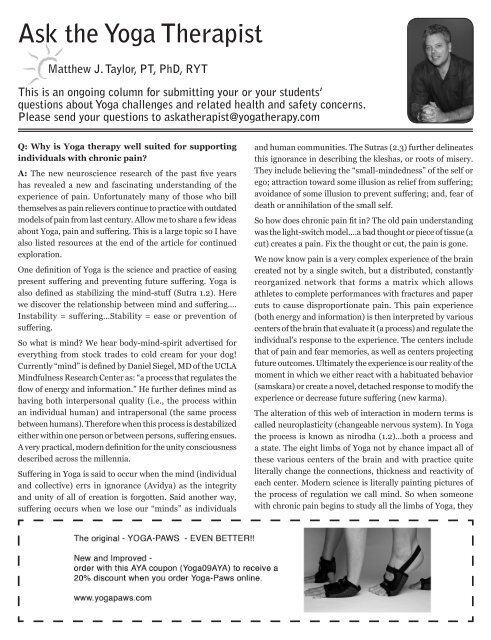Spring 2009 - Arizona Yoga Association
Spring 2009 - Arizona Yoga Association
Spring 2009 - Arizona Yoga Association
Create successful ePaper yourself
Turn your PDF publications into a flip-book with our unique Google optimized e-Paper software.
Ask the <strong>Yoga</strong> Therapist<br />
Matthew J. Taylor, PT, PhD, RYT<br />
This is an ongoing column for submitting your or your students’<br />
questions about <strong>Yoga</strong> challenges and related health and safety concerns.<br />
Please send your questions to askatherapist@yogatherapy.com<br />
Q: Why is <strong>Yoga</strong> therapy well suited for supporting<br />
individuals with chronic pain<br />
A: The new neuroscience research of the past five years<br />
has revealed a new and fascinating understanding of the<br />
experience of pain. Unfortunately many of those who bill<br />
themselves as pain relievers continue to practice with outdated<br />
models of pain from last century. Allow me to share a few ideas<br />
about <strong>Yoga</strong>, pain and suffering. This is a large topic so I have<br />
also listed resources at the end of the article for continued<br />
exploration.<br />
One definition of <strong>Yoga</strong> is the science and practice of easing<br />
present suffering and preventing future suffering. <strong>Yoga</strong> is<br />
also defined as stabilizing the mind-stuff (Sutra 1.2). Here<br />
we discover the relationship between mind and suffering….<br />
Instability = suffering…Stability = ease or prevention of<br />
suffering.<br />
So what is mind We hear body-mind-spirit advertised for<br />
everything from stock trades to cold cream for your dog!<br />
Currently “mind” is defined by Daniel Siegel, MD of the UCLA<br />
Mindfulness Research Center as: “a process that regulates the<br />
flow of energy and information.” He further defines mind as<br />
having both interpersonal quality (i.e., the process within<br />
an individual human) and intrapersonal (the same process<br />
between humans). Therefore when this process is destabilized<br />
either within one person or between persons, suffering ensues.<br />
A very practical, modern definition for the unity consciousness<br />
described across the millennia.<br />
Suffering in <strong>Yoga</strong> is said to occur when the mind (individual<br />
and collective) errs in ignorance (Avidya) as the integrity<br />
and unity of all of creation is forgotten. Said another way,<br />
suffering occurs when we lose our “minds” as individuals<br />
and human communities. The Sutras (2.3) further delineates<br />
this ignorance in describing the kleshas, or roots of misery.<br />
They include believing the “small-mindedness” of the self or<br />
ego; attraction toward some illusion as relief from suffering;<br />
avoidance of some illusion to prevent suffering; and, fear of<br />
death or annihilation of the small self.<br />
So how does chronic pain fit in The old pain understanding<br />
was the light-switch model….a bad thought or piece of tissue (a<br />
cut) creates a pain. Fix the thought or cut, the pain is gone.<br />
We now know pain is a very complex experience of the brain<br />
created not by a single switch, but a distributed, constantly<br />
reorganized network that forms a matrix which allows<br />
athletes to complete performances with fractures and paper<br />
cuts to cause disproportionate pain. This pain experience<br />
(both energy and information) is then interpreted by various<br />
centers of the brain that evaluate it (a process) and regulate the<br />
individual’s response to the experience. The centers include<br />
that of pain and fear memories, as well as centers projecting<br />
future outcomes. Ultimately the experience is our reality of the<br />
moment in which we either react with a habituated behavior<br />
(samskara) or create a novel, detached response to modify the<br />
experience or decrease future suffering (new karma).<br />
The alteration of this web of interaction in modern terms is<br />
called neuroplasticity (changeable nervous system). In <strong>Yoga</strong><br />
the process is known as nirodha (1.2)…both a process and<br />
a state. The eight limbs of <strong>Yoga</strong> not by chance impact all of<br />
these various centers of the brain and with practice quite<br />
literally change the connections, thickness and reactivity of<br />
each center. Modern science is literally painting pictures of<br />
the process of regulation we call mind. So when someone<br />
with chronic pain begins to study all the limbs of <strong>Yoga</strong>, they




